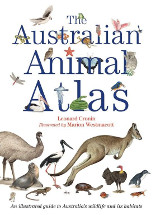The Australian Animal Atlas by Leonard Cronin

Ill. by Marion Westmacott. Allen and Unwin, 2017. ISBN 9781760294144
(Ages: 5-12) Recommended. Australian animals. This is a revised and
updated edition of a 1995 Envirobook publication by the same author
and illustrator. The illustrations are detailed and realistic and
the author, with a background in biology, presents well-researched
information regarding animal behaviour and physiology. The structure
of the book is faultless and multi-layered and the contents and
index pages are uncluttered and easy to navigate. The animals are
organised into the habitats (e.g., deserts) in which they are found
and the contents page lists these eleven habitats. Indexing is by
common grouping (e.g., insects, kangaroos) as well as by full name
(e.g., Bull Ant, Agile Wallaby). Each of the eleven sections contain
a map showing the area/s of Australia that habitat can be found as
well as a brief description and illustration of that particular
habitat. The animals of that habitat (sixteen for each) are depicted
both within the illustration and again within the border (labelled).
Younger children will especially enjoy searching for each animal
within these habitat scenes. On the following page is yet another
illustration of each animal, this time including information
regarding their unique behaviours and abilities. It is a credit to
the publication that the illustrations are not just duplicated; many
of them are different. Because the number of animals included is not
exhaustive the information given is quite comprehensive for a book
of this kind (not just a couple of interesting or little known
titbits), with 3-5 thorough sentences for each. Westmacott's
detailed and life-like illustrations bring the creatures to life.
An illustrated guide such as this is great for visual learners and
allows children to read about an animal and then connect that new
knowledge to the animal's appearance (e.g., to both read about and
see the spade-like feet of the water-holding frog). As illustrated
in the aforementioned example the descriptive language used is
visual and appropriate for a young audience. The monikers (e.g.,
night terror, flying poison) given to each animal will draw
children, including reluctant readers, into the text and encourage
them to read on. The layout is easy on the eye and not text heavy;
there is lots of white space and the illustrations take centre
stage. The text gives each animal's scientific name as well as its
body measurements.
This is a thoroughly enjoyable and educational read, both for
general perusal, habitat investigations and animal research.
Nicole Nelson